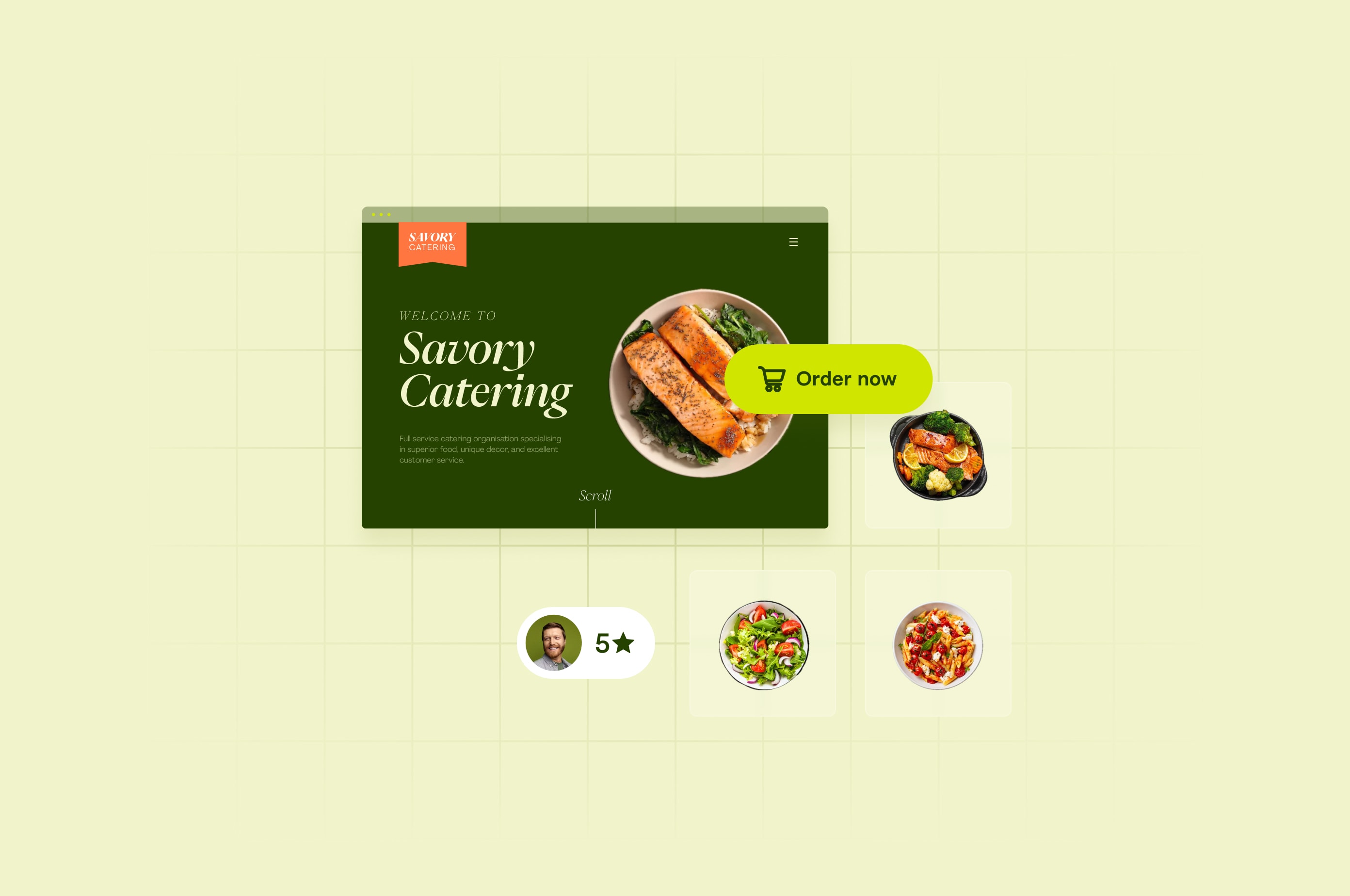How to Start a Catering Business in 2024: 11 Simple Steps
Want to start a catering business? This guide explains what it takes to start a catering business in 11 simple steps, plus real-world examples to inspire your journey.
 March 20, 2024
March 20, 2024 12 minute reading
12 minute reading
Nick is a talented cook. He makes food that’s so good, people always praise him for his culinary chops.
Nick’s close-knit community adores his creamy risotto, roasted shrimp, and lemon arugula salad. Some even joke, “Nick, if you ever start a catering business, we’ll be your everyday customers!”
That idea became the seed that sparked Nick’s seafood catering business, which has grown into a successful venture.
Like Nick, you probably have that catering business spark. Maybe someone commented on a dish you made or the passion has been brewing for a while, and now you’re ready to start your own catering company.
To help you fan that spark to flame, we put together this step-by-step guide, so you can learn everything you need to know about how to start a catering business.
11 steps to start a catering business
Starting a catering business is a great way to turn your passion into profits. But there’s more to catering than putting food on plates.
Before you plan out a menu or hire staff, you’ll need to learn all the ingredients of running a food enterprise, from registration to setting up your shop to marketing to selling to real customers, and more.
There’s no avoiding this reality, but with a little planning and guidance, you'll be delighting guests at any function in no time.
Whether you want to dish up culinary delights at weddings, charity balls, corporate dinners, festivals, or other events, here’s how to start a catering business in 11 simple steps.
Find a business plan writer for hire
1. Learn about the catering industry
Catering is a large and complex industry, with businesses ranging from independent caterers operating from a home kitchen to large catering operations with dozens of workers and truck fleets.
Catering customers are just as varied, from home parties to weddings to festivals to corporate events, and more. Plus, you’ll often collaborate with other providers, like event planners and coordinators offering related services, such as decor or logistics—not just potential clients.
So, it makes sense to learn about the catering and food industry before setting up shop.
You can work a few events as a cook or on-call catering server to learn everything from setting up buffet tables to handling catering equipment and get hands-on experience. Or visit the National Association for Catering and Events (NACE) and The International Caterers Association (ICA) to learn more about the catering industry.
2. Conduct market research
Next, research the market to know who will be your competitors and the kind of customers who are looking for your catering services.
You can use government databases, like Data Axle Reference Solutions, which can give you free information about caterers in the US. Look up catering businesses operating in your metro area or ZIP code to learn about their:
Location
Sales volume
Projected sales
Projected expenses
Contact information
Or do a quick search on Google for caterers in your area, like this one:

All this information will come in handy when writing the competitive analysis and market analysis sections of your catering business plan, so take detailed notes.
3. Find a catering niche and format
Before planning out your catering business, find a niche and decide on the type of business you want to start.
The most common types of catering services include:
Corporate catering: Serves corporate and business events, and range from small onsite office functions to larger offsite or upscale functions.
Wedding catering: Weddings are the largest revenue generator for 52% of caterers. This niche caters to wedding functions but may include extra services, like table arrangement, dish presentation, and decor.
Concession catering: Designed for commercial businesses, like bakeries, coffee shops, or restaurants that buy baked goods or ready-to-eat meals. It also caters to events, like film sets, sports events, live concerts, and seasonal competitions.
Social event catering: Caters to smaller, more intimate functions, like birthdays, baby or bridal showers, grand openings, funerals, bat mitzvahs, and reunions. The type of food you’ll serve will vary depending on the catering events you work at.
When picking a catering business niche, choose one that brings out your strengths and ensure you’re aware of what’s expected of you by your target audience in that niche.
Along with your niche, you’ll need a catering business format. This involves choosing the type of catering space you want to operate out of, such as:
Home-based catering business
Mobile catering truck
Brick and mortar establishment
Ghost kitchen (rented, purchased prep, or leased space)
On-site catering
As your business grows and evolves, you can change the format. For instance, if you choose a home-based catering service, you can switch to a brick-and-mortar location as your customer base and revenues grow.
4. Write a catering business plan
A business plan is a thorough blueprint of how you’ll open and operate your catering business to execute your vision.
When writing your business plan, make sure it contains the following sections:
Executive summary: An overview of your business (history and owner), its purpose, and success strategy.
Financial projections: Outline your company’s projected financial growth, pricing, and expected profit margins to show your planned path to profitability.
Sales and marketing strategy: Outline your marketing/promotional and sales strategies for the first few years.
Competitive and market analysis: Give a general overview of your competitors and the market you’ll operate in at local and national levels.
Business name: Choose a name, run trademark and patent checks on it to see if it’s available for use, then add it to your business plan.
5. Choose the right location
Catering often focuses on gatherings and social events, like weddings, parties, and other social events hosted in banquet halls, hotels, parks, and other event venues.
When picking a location for your own catering business, consider these factors:
The type and size of events you want to serve
Where your ideal type of events are hosted
Your ideal customer’s challenges and how your services will solve them
Your competitors and the areas they serve
Choose where you’ll set up your kitchen and cook from, whether that’s an independent or shared commercial kitchen space, or your home kitchen.
For a new business with a few bookings, a shared kitchen would be a good fit. But if you have an extensive menu with lots of customers, find an independent location. Check with your area health department to know which options they permit in your area.
6. Obtain business licenses and permits
Food businesses often come with several food safety obligations and requirements, which may vary based on your location.
The most common licenses and permits you’ll likely need include:
General business license: Allows you to engage in business activities in your local area and ensures you comply with local zoning ordinances.
Doing Business as (DBA) license: A DBA is the trade name you operate your business under other than the legal company name. You might need to file a DBA before running a catering business under another name.
Employer Identification Number (EIN): This is your catering company’s tax ID, which lets you pay federal taxes, open bank accounts, hire staff, and apply for licenses and permits. You can get an EIN from the Internal Revenue Service (IRS) website.
Home occupation permit: If you wish to run your catering business from your home, you may need a home business license, which lets you start your business and engage in business activities legally from your home.
Food handler permit: Allows you to protect yourself, your customers, and workers. The permit is specific only to you and lets you work legally in the food and beverage industry. If you have employees, ensure they each have a food handler permit.
Caterer permit: Depending on your state or country, you may need a specific caterer permit other than food safety certification or the food handler permit. If you intend to serve alcoholic beverages with your catered meals, you’ll need a caterer’s permit with alcohol license or liquor license.
Restaurant food service license: Required by the local health department, so you can serve food to your customers. Check with your local or secretary of state’s office to apply for the correct one.
Catering business insurance: This isn’t a license or permit, but you must have the right protections in place to cover your workers, yourself, or your property in case of any eventualities. Examples of insurance coverage for small businesses include general liability insurance, commercial property insurance, workers’ compensation insurance, and umbrella insurance.
Besides getting on top of catering business licenses and health permits, it’s also good to collect your tax requirements and documentation as early as you can to avoid unnecessary delays. Research and apply early, so you can stay on track for your business’s opening day.
You can chase the licensing paperwork on your own, but that’s tiring and draining. To prevent headaches down the line, work with a business registration expert, who has experience helping other catering businesses get set up.
7. Design your marketing plan and strategy
Your marketing plan outlines your catering company’s specific marketing strategy, which includes:
Activities you plan to do over a specific time period
Why you want to do those activities
When the activities will be done
How much the activities will cost
The anticipated results of your marketing activities
A marketing strategy is your overall plan to reach new people and convert them into paying customers and repeat visitors.
You can promote your catering business through social media channels, like TikTok, Facebook, Instagram, or X (formerly Twitter), to reach potential customers and connect and engage with your fans. Like this example by Caper’s Catering:
Or engage with your customers through newsletters, email marketing, coupon promos, loyalty updates, or a re-engagement message.
Optimize your company’s website, so people can quickly search for your catering business and find you online. You can also use offline marketing strategies, like billboards, hosting community events, or partner with local charities through food drives and other noble causes.
Design your brand identity to set your business apart from the competition. Ask yourself:
What’s your company’s unique appeal?
What will you offer customers that the competition doesn’t provide?
Then, incorporate the elements that make your catering business unique into your marketing and advertising strategy. This way, you’ll present clear, accessible, and cohesive messaging to your audience before opening your business.
Resources might not be sufficient when starting out, but you can set up your business on platforms like Google My Business and local search. This boosts your local marketing and ensures new customers in your local area can discover your business.
8. Determine your business finances
Catering business operating and startup costs may include:
Food costs
Utilities (gas, water, electricity)
Equipment and appliances
Packaging
Marketing and advertising
Labor
Transport and logistics
Licenses and permits
With these costs in mind, project your catering business sales by subtracting your expenses from your projected revenue. Then, project your growth using a monthly estimate. After a few months of operation, use a more accurate growth rate to project your business growth.
You can save money for the initial outlay of your catering business. Or, consider funding options, such as:
Startup business grants
Equipment financing
Venture capital or angel financing
Local or national bank business credit lines
Look for financing options that best suit your business and incorporate the repayments into your operating costs.
9. Choose a business structure
Before applying for catering licenses and permits, create your business. This requires you to settle on a name and business structure.
A business structure determines how your catering business will be run, managed, and taxed, plus the level of personal liability when it comes to legal proceedings and debts.
The most common types of business structures are:
Sole proprietorship: Ideal if you plan to operate your business by yourself and keep things simple. It’s easy to form but doesn’t protect your personal assets in case of a lawsuit or bankruptcy. As the business owner, you report all income or losses on your personal income tax return. Your business won’t be taxed separately.
Limited liability company (LLC): Ideal if you want to run your business with other LLC members. It’s a separate business entity from your individual person and may protect your personal assets. LLC members are responsible for paying self-employment taxes.
Need help determining the best business structure for your catering company? Reach out to one of Fiverr’s business consultants, tax consultants, or legal experts for professional help.
10. Purchase equipment and supplies
You’ll also need to purchase cooking, food storage, and refrigeration equipment, such as:
Ovens
Freezers and refrigerators
Chafing dishes
Tables
Dishware
If you’re cooking from an already-stocked commercial or home kitchen, you might not need all these, so your purchases will be fewer than when starting with an empty space.
If you can’t afford such equipment, you can lease from event rental companies and pass the costs onto your customers. It’s a great way to give your clients options to pick stylish serving items for their events.
When your business grows, you can have your own equipment and charge customers for their use instead of paying rental companies.
Open accounts with food suppliers for general supplies, like paper goods and starting food inventory. If you don’t have enough sales volume, discount clubs like Sam’s Club and Costco are a good place to start.
11. Market your business
Running a successful catering business is more than delivering dazzling dishes and service with a smile. You need to attract new guests, tell potential clients how to find your business, and retain existing ones in a sea of thousands of catering and dining options. This can win repeat business and long-term loyalty.
What will set you apart is how you market your business, communicate with customers, and offer the best experience.
When starting, word-of-mouth and referrals can give your business the mileage to get new customers, but it’s not enough on its own. Blend different catering marketing initiatives and strategies, like:
Food Republic, for example, leverages influencer marketing through Instagram takeovers.
The food court chain allows chefs who have an influential presence to take over their Instagram account using the hashtag #FRTakeover for a short period, during which they can post anything that feels natural to them. This strategy boosts the company’s following every time and today, Food Republic boasts over 410,000 followers on Instagram.

Your business website is another important part of your marketing plan and strategy. Ensure it has menus with mouthwatering images of your food, past events you’ve catered, and a contact form to take inquiries and orders.
In addition to digital marketing tools, you also need traditional advertising materials, such as flyers, business cards, and paper menus. You can design these yourself using graphic design tools or hire a talented graphic designer from Fiverr who will make your business stand out.
Turn your culinary passion into profit
Starting a catering business is an exciting adventure. However, catering has a lot of moving pieces and deals with a ton of information.
With a solid plan, passion, creativity, commitment to excellence (and these 11 steps) you can set yourself on the path to catering success.
As with any business, you can only go so far alone. But it doesn’t have to be that way—hire professional catering business experts on Fiverr with skills ranging from business planning to market research to marketing.
Fiverr gives you access to a variety of freelancers in different fields of expertise and streamlines managing freelancers, projects, and finances from a single dashboard—at no monthly charge.
Ready to set up your catering business? Sign up for Fiverr to find and work with talented freelancers today.




